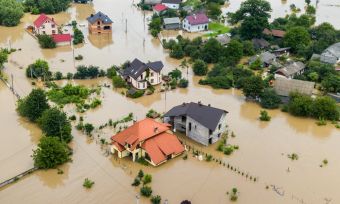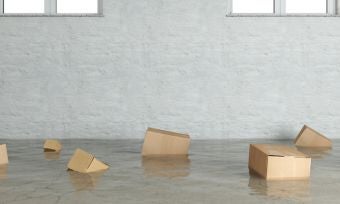A natural disaster can happen at any time. But while you can’t predict when they will strike, you can prepare your home and contents insurance so it’s there to protect your financial future if the worst does happen. Canstar explores how to prepare your home and contents insurance to stop a natural disaster turning into a financial crisis.
Assess the risks your home faces
From fire, to flooding and earthquakes, depending on where you live, your home will face different risks. These in turn will affect the insurance premiums you pay.
In the past, insurers spread their risk costs across all their customers. But now they are taking a more risked-based approach. This means that if your home is situated in an area prone to natural disasters, you’ll pay higher insurance premiums than somebody with a home in a low-risk area.
If you don’t already know what dangers are present in your area, you can find details of your risk profile in a couple of places:
- Your home’s Land Information Memorandum (LIM) report will show natural hazards for your property. If you don’t have an up-to-date one, you can order one from your local council
- Check your regional council’s website. Many have interactive maps that show, for example, flood-prone areas
- District Plans also reveal information on natural hazards, and can show details not included on LIMs
Evaluate your insurance needs
If you live in an area that faces increased risks of natural disasters, unfortunately, there is little you can do to mitigate those risks. However, knowing the dangers you face does mean you can be better prepared should calamity strike.
And this involves checking your home and contents insurance closely to ensure you’ve the correct level of cover.
How much would it cost to rebuild your house?
It’s easy to set and forget the home part of your home and contents insurance. But if you don’t regularly assess how much it would cost to rebuild your home, it could be a very expensive oversight in the event of a disaster.
The cost of building materials has increased dramatically over the past two years. Based on planning applications, to the end of 2021, nationally, the average price of a new build per m² increased from $2359 (2020) to $2463 (2021). That’s an increase of 4.4%.
However many builders and architects are now budgeting a cost of around $3500m2 per metre for a normal family home. So, based on the size of your house, how much would it cost you to rebuild?
→ Related article: How Much to Build a New House in NZ?
Does your contents insurance cover new for old?
There are two types of contents insurance:
- New for old cover – replaces your lost or damaged possessions with comparable new items
- Indemnity value cover – only pays the value of your damaged possessions at the time of their loss.
While new-for-old contents insurance is more expensive than indemnity value cover, in the event of a disaster, it could save you tens of thousands of dollars. Second-hand goods depreciate in value very quickly.
And with only indemnity value cover to fall back on, if you’re faced with replacing a home’s worth of possessions, you could face a major shortfall between your insurance payout and the cost of the new items.
Calculate how much contents insurance you need
It’s important to create an inventory of your home’s contents, so you know exactly what to claim from your insurer. The first time you do this, it will be time consuming, but from there it will be quick and easy to update the list annually. Back up your itemised list with photos, videos and receipts, if possible, for high-value items.
Some insurance companies have calculators on their websites that will estimate the contents cover for your home. While these can be useful, they only provide a rough guide. For a more precise total, you need to do the maths yourself. While you don’t want to pay for insurance you don’t need, you don’t want to find your cover lacking in the event of a claim.
The total amount of money required to replace all your possessions is called the sum insured. It’s the maximum amount you can claim. It’s worth noting that if you lose your possessions, you won’t simply be given the sum insured amount. Your insurer will only pay what is required. So if they can replace all your contents for less than the sum insured, they will.
What else to consider:
Don’t forget about cars and other vehicles
Don’t just assume that your car is covered for floods or other natural disasters. This is especially important if you don’t have comprehensive car insurance. If you’ve only third-party, or third-party fire and theft, you could be left out of pocket if you lose your car in a flood or other natural disaster.
→ Related article: Does Car Insurance Cover Flood Damage?
Protect valuables
If you have particularly valuable possessions, for example jewellery or artwork, you will need to add cover for these items separately on your contents policy.
Protect your key documents
Passports, wills, insurance policies, birth and marriage certificates, deeds and other vital paperwork might not have great financial worth, but replacing them can still be expensive, and involve onerous amounts of red tape. Whatever your home’s risk of natural disaster, it always pays to keep important documents together in a fire and waterproof container. As a back-up, keep digital copies on an external hard drive, using password protection or, preferably, in the cloud.
About the author of this page
 This report was written by Canstar’s Editor, Bruce Pitchers. Bruce began his career writing about pop culture, and spent a decade in sports journalism. More recently, he’s applied his editing and writing skills to the world of finance and property. Prior to Canstar, he worked as a freelancer, including for The Australian Financial Review, the NZ Financial Markets Authority, and for real estate companies on both sides of the Tasman.
This report was written by Canstar’s Editor, Bruce Pitchers. Bruce began his career writing about pop culture, and spent a decade in sports journalism. More recently, he’s applied his editing and writing skills to the world of finance and property. Prior to Canstar, he worked as a freelancer, including for The Australian Financial Review, the NZ Financial Markets Authority, and for real estate companies on both sides of the Tasman.
Enjoy reading this article?
Sign up to receive more news like this straight to your inbox.
By subscribing you agree to the Canstar Privacy Policy










Share this article